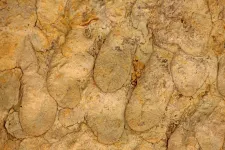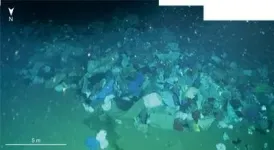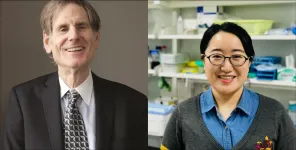Newly discovered fossil named after U of A paleontologist
Former grad student discovers new trace fossil and names it in honor of former supervisor Murray Gingras
2021-01-27
(Press-News.org) A newly discovered trace fossil of an ancient burrow has been named after University of Alberta paleontologist Murray Gingras. The fossil, discovered by a former graduate student, has an important role to play in gauging how salty ancient bodies of water were, putting together a clearer picture of our planet's past.
"One could not find a more passionate and influential teacher of science in the classroom, in the field or at a conference," said Ryan King, lead author of the study and now an adjunct professor at Western Colorado University.
"Naming the fossil after Gingras was a straightforward decision since his research focuses on tying modern observations of how salinity and substrate affect organism burrowing to ancient burrow appearance and species abundance trends."
Trace fossils are a type of fossil that preserves activity of ancient life in the geological record. They include fossilized footprints, nests, droppings and, in this case, a fossilized burrow dug by an organism that lived in a watery environment.
The fossilized burrow, named Glossifungites gingrasi, is from the late Cretaceous of central Utah and was home to water-dwelling insects, similar to mayflies, more than 90 million years ago.
"Fossils like this are significant because they help us narrow down what type of organism dug the burrow--which in turn will tell us about the salinity of the water in which they lived," said King.
Many organisms make use of burrows for shelter and protection while they feed. These animal-constructed sedimentary structures give researchers a clearer picture of biological communities and are important in understanding ancient rivers, bays, estuaries and oceans through their oxygenation levels and saltiness, King explained.
Murray Gingras, professor in the Department of Earth and Atmospheric Sciences, was the co-advisor for King's doctoral studies and for the master's degree of another researcher on the team, Andrew La Croix, now an assistant professor at the University of Waikato.
"I was surprised and honoured," said Gingras of the recognition. "The graduate student and supervisor relationship is a strong one. Graduate students become the colleagues that you care about the most. Having a graduate student honour you by formally naming a fossil after you is wonderful, because you understand then just how reciprocal the relationship is."
"I have been recognized with a few different awards over the years, but nothing really came close to the pride and elation I felt when Ryan informed me that he and Andrew formally named a trace fossil for me."
The study, "Glossifungites gingrasi n. isp., a probable subaqueous insect domicile from the Cretaceous Ferron Sandstone, Utah," was published in The Journal of Paleontology.
INFORMATION:
[Attachments] See images for this press release:

ELSE PRESS RELEASES FROM THIS DATE:
2021-01-27
Boulder, Colo., USA: Benthic plastic litter is a main source of pollutants in oceans, but how it disperses is largely unknown. This study by Guangfa Zhong and Xiaotong Peng, published today in Geology, presents novel findings on the distribution patterns and dispersion mechanisms of deep-sea plastic waste in a submarined canyon located in the northwestern South China Sea.
Evidence collected from a series of manned submersible dives indicate that the plastic litter items transported and deposited in the canyon are most likely controlled by turbidity currents. Here the plastic litter items are highly heterogeneously distributed: Up to 89% of them occur in a few scours of the canyon.
The plastic items are mostly accumulated in longitudinal litter piles of 2-61 m long, 0.5-8 m wide, ...
2021-01-27
JANUARY 26, 2021, NEW YORK - A study led by Ludwig Chicago Co-director Ralph Weichselbaum and Yang-Xin Fu of the University of Texas Southwestern Medical Center has shown how bacteria in the gut can dull the efficacy of radiotherapy, a treatment received by about half of all cancer patients. Their findings appear in the current issue of the Journal of Experimental Medicine.
"Our study identifies two families of gut bacteria that interfere with radiotherapy in mice and describes the mechanism by which a metabolite they produce--a short chain fatty acid called butyrate--undermines the therapy," said Weichselbaum.
A wide variety of commensal bacteria inhabit ...
2021-01-27
Birds play an underrecognized role in spreading tickborne disease due to their capacity for long-distance travel and tendency to split their time in different parts of the world - patterns that are shifting due to climate change. Knowing which bird species are able to infect ticks with pathogens can help scientists predict where tickborne diseases might emerge and pose a health risk to people.
A new study published in the journal Global Ecology and Biogeography used machine learning to identify bird species with the potential to transmit the Lyme disease bacterium (Borrelia burgdorferi) to feeding ticks. The team developed a model that identified birds known to spread Lyme disease with 80% accuracy and flagged 21 new species that should be prioritized for surveillance.
Lead author Daniel ...
2021-01-27
The rapid development of two-dimensional quantum materials, such as twisted bilayer graphene, monolayer copper superconductors, and quantum spin Hall materials, has demonstrated both important scientific implications and promising application potential. To characterize the electronic structure of these materials/devices, angle-resolved photoemission spectroscopy (ARPES) is commonly used to measure the energy and momentum of electrons photoemitted from samples illuminated by X-ray or vacuum ultraviolet (VUV) light sources. Although the X-ray-based spatially resolved ARPES has the highest spatial resolution (~100 nm) benefitting from the relatively short wavelength, its energy resolution is typically mediocre (>10 meV), ...
2021-01-27
The overuse of antibiotics occurs due to the mistaken widespread belief that they are beneficial for a broad array of conditions and because many physicians are willing to prescribe antibiotics if patients ask for the medication, according to a Rutgers study.
The study, published in the journal BioEssays, reviewed more than 200 peer-reviewed studies to examine the causes behind antibiotic overuse, which can lead harmful bacteria to become drug-resistant and cause harmful effects on the microbiome, the collection of beneficial germs that live in and on our bodies.
Martin Blaser, director of the Center for Advanced Biotechnology and Medicine at Rutgers and lead author, said the global use of antibiotics between 2000 and 2015 increased 39 percent, with ...
2021-01-27
p>AUSTIN, Texas -- Trauma-focused psychotherapy is widely considered the best available treatment for posttraumatic stress disorder (PTSD). However, the ways in which this method affects the brain to promote recovery from PTSD are not well understood. In a END ...
2021-01-27
A research group from Kumamoto University (Japan) has developed an automated measurement system to assess healthy lifespans using nematodes (C. elegans). Based on qualitative differences in lifespans, this system can classify populations of nematodes that are, on average, healthy and long-lived, healthy and die prematurely, and living with long periods of poor health. Since there are many similarities between the mechanisms that determine the lifespan of C. elegans and humans, the researchers believe that this system will make it easier to develop drugs and find foods that extend the ...
2021-01-27
A tree grows strong from years of generating its own food. Now imagine if products could be strengthened with the same living materials that provide nutrients to strengthen trees. This is the work of USC Viterbi School of Engineering Civil and Environmental Engineering Professor Qiming Wang whose research lab is one of the first to infuse 3-D printer ink with living material. The material has potential for greater strength, to be flexible and self-heal. The work is documented in a paper published in The Proceedings of the National Academy of Sciences.
The idea for this bio-inspired ink came from trees that harness the power of photosynthesis to produce glucose that transform to ...
2021-01-27
In our body, unnecessary cells are removed by regulated cell death. Understanding of the mechanism underlying regulated cell death is critical for the development of therapies for many diseases. Professor Nakano's research group has demonstrated that Mind bomb-2 (MIB2), a ubiquitin ligase, binds to and directly ubiquitinates the cell death suppressor protein cFLIP (Cellular FLICE-inhibitory protein). cFLIP is encoded by CFLAR gene; alternative splicing results in two forms, the long form (cFLIPL) and the short form (cFLIPs). cFLIPL plays a dominant role in suppression ...
2021-01-27
January 27, 2021 - For many of us, as we get older the skin on our face begins to sag and we seem to lose volume around our eyes, cheeks and chin. Is gravity taking its toll in our later years or do we lose fat over the course of several years that many of us associate with youth, vibrancy and energy? Understanding the cause is paramount to how plastic surgeons treat the signs of facial aging.
The traditional theory is sagging: the facial soft tissues simply yield to the effects of gravity over time. And while the idea that weakening ligaments in the midface could result in soft tissue descent still has merit, more recent studies point in another direction. Perhaps the real culprit behind facial aging ...
LAST 30 PRESS RELEASES:
[Press-News.org] Newly discovered fossil named after U of A paleontologist
Former grad student discovers new trace fossil and names it in honor of former supervisor Murray Gingras







